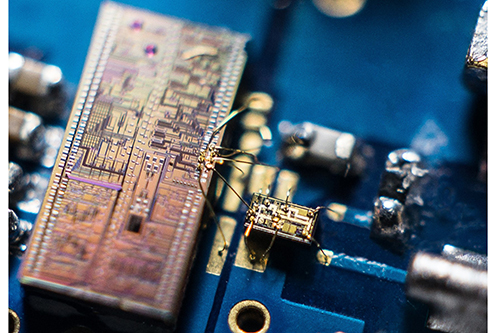Nov 10 2020
Scientists from the Quantum Engineering Technology Labs (QET Labs) at the University of Bristol’s, as well as from Université Côte d‘Azur, have developed a new miniaturized light detector that can perform in-depth quantification of quantum features of light like never before.
 The integrated detector combines a silicon photonic chip with a silicon micro-electronics chip, yielding advanced speed in detecting quantum light. Image Credit: University of Bristol.
The integrated detector combines a silicon photonic chip with a silicon micro-electronics chip, yielding advanced speed in detecting quantum light. Image Credit: University of Bristol.
Built using two silicon chips that work in tandem, the device was used to quantify the exclusive properties of “squeezed” quantum light at high speeds than achieved ever before.
Leveraging the exclusive properties of quantum physics opens innovative pathways to outshine the existing advancement in communication, computing, and measurement. Silicon photonics, which involves using light as the information carrier in silicon microchips, is an interesting avenue towards these futuristic technologies.
Squeezed light is a quantum effect that is very useful. It can be used in quantum communications and quantum computers and has already been used by the LIGO and Virgo gravitational wave observatories to improve their sensitivity, helping to detect exotic astronomical events such as black hole mergers. So, improving the ways we can measure it can have a big impact.
Joel Tasker, Study Co-Lead Author, University of Bristol
Quantification of squeezed light necessitates detectors designed exclusively for ultra-low electronic noise, to detect the weak quantum features of light. However, to date, detectors such as these have been limited in the speed of signals that can be quantified—around 1000 million cycles per second.
This has a direct impact on the processing speed of emerging information technologies such as optical computers and communications with very low levels of light. The higher the bandwidth of your detector, the faster you can perform calculations and transmit information.
Jonathan Frazer, Study Co-Lead Author, University of Bristol
Thus far, the combined detector has been clocked at an order of magnitude quicker compared to the previous advancement, and the researchers are now working to refine the technology to work much faster.
The size of the detector is less than 1 mm2—such a small size ensures the high-speed performance of the detector. The detector has been developed using silicon microelectronics and a silicon photonics chip.
Scientists across the globe have been analyzing ways to combine quantum photonics in a chip to demonstrate scalable manufacture.
Much of the focus has been on the quantum part, but now we’ve begun integrating the interface between quantum photonics and electrical readout. This is needed for the whole quantum architecture to work efficiently. For homodyne detection, the chip-scale approach results in a device with a tiny footprint for mass-manufacture, and importantly it provides a boost in performance.
Jonathan Matthews, Professor and Project Director, University of Bristol
Journal Reference:
Tasker, J. F., et al. (2020) Silicon photonics interfaced with integrated electronics for 9 GHz measurement of squeezed light. Nature Photonics. doi.org/10.1038/s41566-020-00715-5.